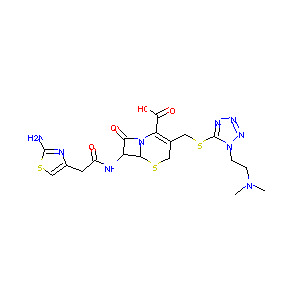Details of the Drug
General Information of Drug (ID: DMF5HU6)
| Drug Name |
Cefotiam
|
||||||||||||||||||||||
|---|---|---|---|---|---|---|---|---|---|---|---|---|---|---|---|---|---|---|---|---|---|---|---|
| Synonyms |
Aspil; CTM; Cefotiamum; Ceradolan; Haloapor; CEFOTIAM HYDROCHLORIDE; CGP 14221E; Abbott-48999; Aspil (TN); Cefotiam (INN); Cefotiam [INN:BAN]; Cefotiamum [INN-Latin]; SCE-963; CGP-14221-E; (6R,7R)-7-[2-(2-Amino-thiazol-4-yl)-acetylamino]-3-[1-(2-dimethylamino-ethyl)-1H-tetrazol-5-ylsulfanylmethyl]-8-oxo-5-thia-1-aza-bicyclo[4.2.0]oct-2-ene-2-carboxylic acid; (6R,7R)-7-[[2-(2-amino-1,3-thiazol-4-yl)acetyl]amino]-3-[[1-(2-dimethylaminoethyl)tetrazol-5-yl]sulfanylmethyl]-8-oxo-5-thia-1-azabicyclo[4.2.0]oct-2-ene-2-carboxylic acid; (6R,7R)-7-{[(2-amino-1,3-thiazol-4-yl)acetyl]amino}-3-[({1-[2-(dimethylamino)ethyl]-1H-tetrazol-5-yl}sulfanyl)methyl]-8-oxo-5-thia-1-azabicyclo[4.2.0]oct-2-ene-2-carboxylic acid; (6R,7R)-7-{[(2-amino-1,3-thiazol-4-yl)acetyl]amino}-3-[({1-[2-(dimethylamino)ethyl]-1H-tetrazol-5-yl}thio)methyl]-8-oxo-5-thia-1-azabicyclo[4.2.0]oct-2-ene-2-carboxylic acid; 7b-[2-(aminothiazol-4-yl)acetamido]-3-[[[1-(2-dimethylaminoethyl)-1h-tetrazol-5-yl]thio]methyl]ceph-3-em-4-carboxylic acid; 7beta-(2-amino-1,3-thiazol-4-yl)acetamido-3-[({1-[2-(dimethylamino)ethyl]-1H-tetrazol-5-yl}sulfanyl)methyl]-3,4-didehydrocepham-4-carboxylic acid
|
||||||||||||||||||||||
| Indication |
|
||||||||||||||||||||||
| Therapeutic Class |
Antibiotics
|
||||||||||||||||||||||
| Drug Type |
Small molecular drug
|
||||||||||||||||||||||
| Structure |
 |
||||||||||||||||||||||
| 3D MOL | 2D MOL | ||||||||||||||||||||||
| #Ro5 Violations (Lipinski): 3 | Molecular Weight (mw) | 525.6 | |||||||||||||||||||||
| Logarithm of the Partition Coefficient (xlogp) | -2.4 | ||||||||||||||||||||||
| Rotatable Bond Count (rotbonds) | 10 | ||||||||||||||||||||||
| Hydrogen Bond Donor Count (hbonddonor) | 3 | ||||||||||||||||||||||
| Hydrogen Bond Acceptor Count (hbondacc) | 13 | ||||||||||||||||||||||
| ADMET Property |
|
||||||||||||||||||||||
| Chemical Identifiers |
|
||||||||||||||||||||||
| Cross-matching ID | |||||||||||||||||||||||
Molecular Interaction Atlas of This Drug
 Drug Therapeutic Target (DTT) |
|
||||||||||||||||||||||||||
|---|---|---|---|---|---|---|---|---|---|---|---|---|---|---|---|---|---|---|---|---|---|---|---|---|---|---|---|
 Drug Transporter (DTP) |
|
||||||||||||||||||||||||||
| Molecular Interaction Atlas (MIA) | |||||||||||||||||||||||||||
References
